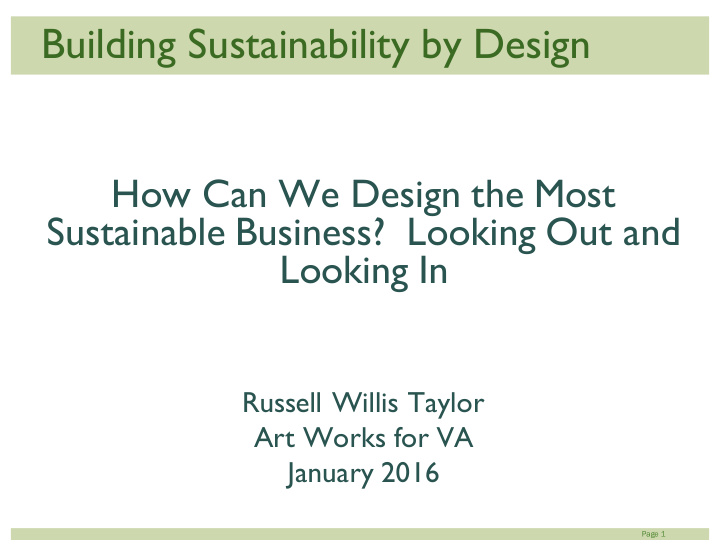



Building Sustainability by Design How Can We Design the Most Sustainable Business? Looking Out and Looking In Russell Willis Taylor Art Works for VA January 2016 Page 1
Page 2
The cultural leader’s challenge Balancing preservation and innovation to produce value and meaning for ever-changing audiences. Page 3
The real voyage of discovery consists not in seeking new landscapes, but in having new eyes. Marcel Proust Page 4
What should leaders know how to do? Clarity of compelling purpose (vision) Resilience Flexible Business Models Commitment to creating value outside the organization Community creation skills Domain Expertise (passion for the art form) Page 5
Resilience Page 6
It’s all about the people Page 7
What has changed that changes us? Shift of wealth creation from west to east DIY health: proliferation of apps and gadgets Dealer Chic: fixed price is so last decade Eco-cycology: green is no longer optional Cash-less: unless that green is real money Urban Pyramid: Prahalad’s prescience Point and Know: Visual info-gratification Source: trendwatching.com Page 8
Societal Trends Growth of wealth inequality Spread of market thinking Page 9
The Biggest Change disintermediation Page 10
Social Innovations and Inventions • Social Innovations Pop up restaurants, You-tube, facebook, online transactions, carbon trading, microcredit, cognitive behavioural therapy for prisoners, El Sistema, consumer cooperatives, online learning platforms, virtual learning environments, police community support officers, corporate universities, citizen reporters, cloud funding, fair trade, pledgebanks, restorative justice, open source, slow food, eco-cities, consumer co-operatives, zero carbon housing, wind farms, Hole in the Wall computers, Mumsnet, World Café, flash mobs, Pinterest; Fan Fiction; You Tube Orchestra… • Inventions i-pod; i-phone, i-tunes, tesla electric car, AbioCor artificial heart, Blu-ray players, Solar roof shingles, smart bullets, open space technology, 3-D printing on demand… Page 11
MEdia: new technologies and me You Tube: 72 hours of video uploaded every minute of every day of every year. Page 12
Too Much Information? The modern world overwhelms people with data and this overabundance is both "confusing and harmful" to the mind. Conrad Gessner Swiss scientist RE: Guttenberg Press Page 13
Who takes part? Audiences have an increasing appetite for participation, not just passive observation. People want to play as well as pay. Page 14
Domain Challenge 1: Power and Politics Page 15
Re: Policy If you are not at the table, you are probably on the menu. Page 16
Domain Challenge 2: Perspective Page 17
Domain Challenge 3: Legitimacy Page 18
Domain Challenge 4: Resilience Page 19
The Future: Reconsider amateurs Distinguished Concerts International New York Cultural Olympiad: RSC Open Stages Page 20
The Future: Collective Impact Newcastle Gateshead Cultural Venues Collaboration http://gnculturalvenues.ning.com/ Page 21
The Future: Business Forms Frugal Engineering for the Arts Six Impossible Things Before Breakfast blog, 7.14.12 The Lean Startup by Eric Ries Page 22
New Design: MVP Page 23
New Design: Waterfall vs Agile Gwydion Suilebhan Page 24
Page 25
Looking Out: Audience Centered Organizations Page 26
Price is what you pay, value is what you get. Warren Buffet Page 27
What value are you creating? “People don’t want a quarter-inch drill -- they want a quarter-inch hole.” -Ted Levitt via Andrew Taylor, Artful Manager Page 28
Do you speak Visual? Learning Visual language Toledo Museum of Art | June 2015 29 Page 29
VISUAL LITERACY The ability to read, comprehend, and write visual language. 30 Page 30
Toddler Time Tours February 2014 Docent-led Toddler Tours began 31 Page 31
Could We Matter More If We believed that every aspect of our work is about: • Profound learning? • Making up for gaps in the system? • Contributing to a civil society? • Creating communities, not just audiences? • Helping everyone access the expressive life? Page 32
Slow Food Arts organizations need to stop selling their own excellence and instead focus on brokering relationships between people and art, people and artists, and people and other people. Diane Ragsdale, Jumper Blog 2012 Page 33
Building communities, not audiences Page 34
Our Enduring Value The arts are what we find again when the ruins are cleared away. Katherine Anne Porter 1940 Page 35
Cultural Leaders as Advocates Not for profit: Why Democracy Needs the Humanities Martha Nussbaum 2012 Page 36
The Power of the Arts Educators only interested in economic growth will do more than ignore the arts. They will fear them. For a cultivated and developed sympathy is a particularly dangerous enemy of obtuseness, and moral obtuseness is necessary to carry out programs of economic development that ignore inequality. Martha Nussbaum Not for Profit: Why Democracy Needs the Humanities, 2011 Page 37
Empathy Map Page 38
Arts and Culture create meaning outside of markets – a radical act in the modern world. Page 39
Page 40
Recommend
More recommend